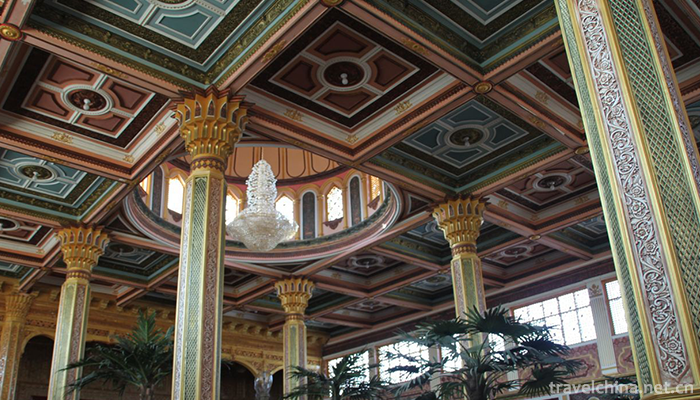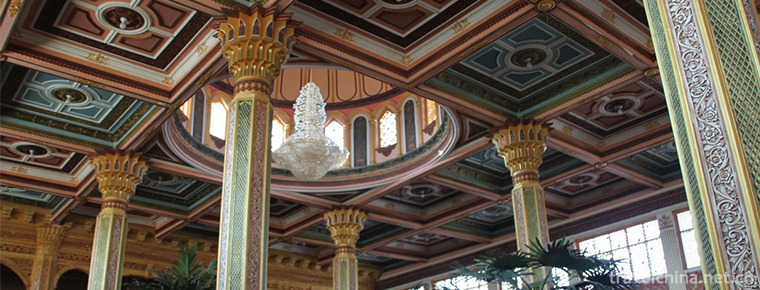Uygur Residential Architecture Skills Aiwan Sailai Residential Construction Skills
Uygur Residential Architecture Skills Aiwan Sailai Residential Construction Skills
Declaration area or unit: Hetian area, Xinjiang Uygur Autonomous Region
Uygur Aiwan Sailai dwellings are mainly distributed in towns and villages along the desert edge of the Tarim Basin, especially in Yutian, Moyu, Minfeng, Pishan, Hetian, Shache and Kashgar along the southern edge of the Tarim Basin desert.
Aiwan Sailai is a typical Uygur residential building form in Hetian. Aiwan refers to a square building with bright and ventilated meanings in the middle of the roof. Sailai refers to the living room or the place where guests are entertained in this kind of building. The whole building is called Aiwan Sailai.
The space in Aiwan is generally divided into two parts: the open courtyard space and the enclosed living room space. Aiwan is a closed, atrium-style layout. The living space consists of living rooms, dining rooms, back rooms, storage rooms, showers and other small rooms. The front rooms facing the courtyard are mostly equipped with external corridors, and the bottom corridors are mostly equipped with solid and non-heating kangs, namely "bundle covers", for sitting outdoors. Aiwangsai has no clear central axis, the layout of the plane is very flexible, the courtyard and building area is not fixed, can be large or small, according to population and economic conditions.
In the aspect of architectural decoration, Hetian Aywang mostly adopts the method of contrast between the real and the virtual, and mainly adorns. Gallery eaves paintings, mostly mosaic tiles, wood carvings and window edge decorations, mostly flowers and plants or geometric figures. Its decoration is mainly in the portico, Aiwang side windows and other parts, mainly wood carving, exquisite carving.
Uygur Aywan Sailai residential building construction techniques are mainly handed down by teachers, all of them are male, there is no written record, and handed down from generation to generation by oral and heart-to-heart teaching methods. With the popularization and popularization of modern residential building forms, the number of experienced folk craftsmen has decreased, and the traditional Aywan Saili residential building technology is in an endangered situation.


-
1.Yibin burning Noodles
The Yibin burning Noodles is one of the most distinctive traditional snacks in Yibin
Time 2018-10-12 -
2.Huanglong Scenic Area
Huanglong Scenic Spot, World Natural Heritage, World Human and Biosphere Reserve, Green Globe 21 Certificate, National AAAAA Tourist Spot, National Key Scenic Spot.
Time 2018-12-12 -
3.Golden Peacock Hot Spring Resort
Anhui Jinpeacock Hot Spring Resort is a commercial resort hotel which integrates vacation, fitness, leisure, entertainment, catering and accommodation. It covers an area
Time 2019-01-26 -
4.Fried Wudong with XO sauce
Ingredients: 2 packs of instant Wudong, 4 or 2 pieces of pork shreds (about 160g), 1/2 cups of onion shredded, celery shredded and carrot shredded, 1 egg, 4 tablespoons of XO sauce, 1 tablespoon of ra
Time 2019-03-23 -
5.Quail gruel
Ingredients: Quail, 100 grams of Japonica rice, 20 grams of red beans, 3 pieces of ginger, 10 grams of cooking wine, proper amount of salt, monosodium glutamate, pepper and sesame oil.
Time 2019-03-24 -
6.Eight treasures bean curd
Babao bean skin is a delicacy. Main raw materials: bean curd 6 white sesame 25 grams pig meat 120 grams of letinous edodes.
Time 2019-03-25 -
7.Anguo City
Anguo City, formerly known as Qizhou, is now the jurisdiction area of Baoding City, Hebei Province, 100 kilometers south of Shijiazhuang, the provincial capital.
Time 2019-03-30 -
8.Korean Crane Dance
Crane Dance of the Korean Nationality has a long history and is a unique dance performance form of the Korean Nationality in China. It has the national characteristics and the value of artistic resear
Time 2019-04-16 -
9.Pumi rubbing
Pumi nationality rubbing "rubbing consultation" is Pumi language, "rubbing" means dancing, "rubbing" means dancing, that is, dancing. When dancing, the leader strikes the
Time 2019-06-09 -
10.Tajik Water Diversion Festival and Seeding Festival
In Tashkurgan Tajik Autonomous County of Xinjiang, Tajik Water Diversion Festival and Seeding Festival are Tajik agricultural festivals. In Tajik, the sowing Festival is called "Hamozivast"
Time 2019-06-17 -
11.Year of the Yi Nationality
In the year of the Yi people, the Yi language is called "Kusi", "Ku" is the year of the Yi people and "Si" is the new year. It means "New Year". It is a traditi
Time 2019-07-12 -
12.Suining first industry
In 2019, the total output value of agriculture, forestry, animal husbandry and fishery in Suining will reach 30.998 billion yuan, an increase of 3.4% over the previous year.
Time 2020-12-16